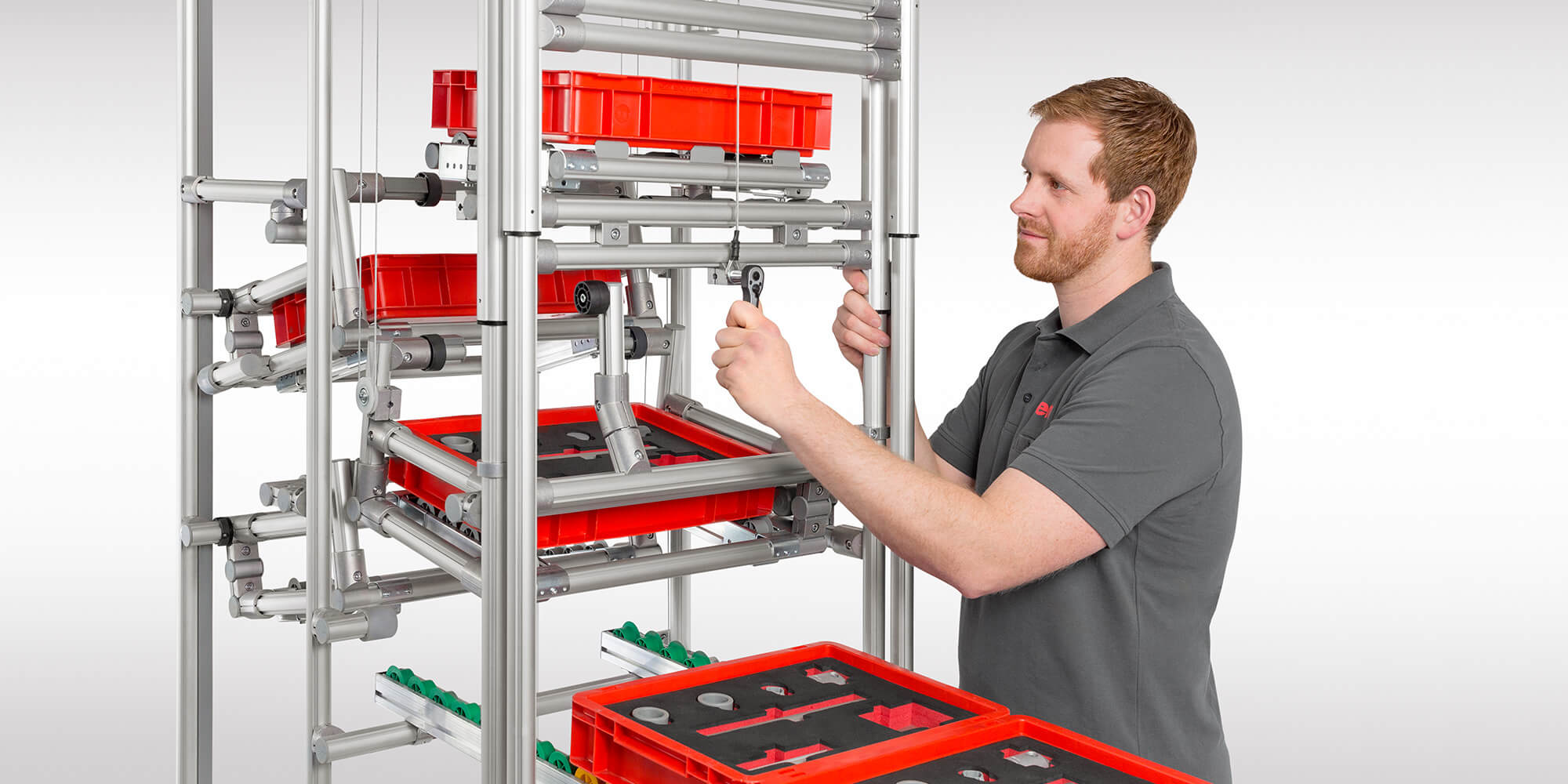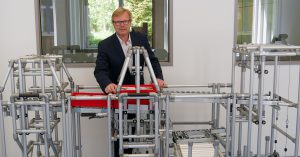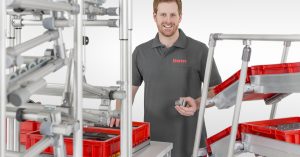Each year, car manufacturer Toyota in Japan trains around 400 of its skilled workers in Karakuri/LCA (= low cost automation) – and yet this special lean production method is still relatively unknown in Europe.
Karakuri/LCA is a form of automation that doesn’t use electricity, sensors, controllers or programming – instead, it primarily relies on the laws of gravity and mechanics. Karakuri/LCA can often replace a traditional automation solution – and the costs involved are much lower. “However, up until now, there has been a lack of independent evidence proving the cost efficiency of Karakuri/LCA. As a university, we are truly independent, so we took on this task,” explains Professor Volker Ahrens. Professor Ahrens, who holds the Chair of Production Management at NORDAKADEMIE Hochschule der Wirtschaft, focuses on Karakuri/LCA in his research and teaching. He supervised a practical project carried out by six industrial engineering students, who used our Lean Production Building Kit System to put Karakuri/LCA to the test as part of their Master’s course.
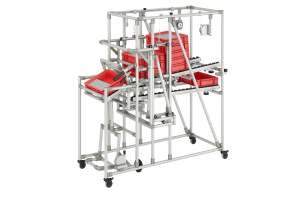
Discover all the advantages of Karakuri/LCA
Lean production taken one step further: Use the laws of gravity and mechanics to intelligently automate processes. At 10 to 20 percent lower costs.
Inform now
Two different approaches to an automation task
The specific aim of the project was to compare two different solutions for the following automation task – transporting a small load carrier (SLC) containing a gearbox weighing six kilograms over an obstacle measuring two metres in height and three metres in length. The biggest challenge was damping and decelerating the loads being transported. Although a complete design was produced for both a Karakuri/LCA solution and a conventional automation application with an electrically powered lift and conveyor belt, only the first of these was actually built. “It became apparent that the conventional solution would be much more expensive, so it wouldn’t have made financial sense to build this one, too,” explains Finnja Kietzke, a member of the project team. Since both systems were planned using item components, the costs of both solutions could be compared on a realistic basis. In the end, when material and labour costs were calculated, it transpired that Karakuri/LCA offered savings of around 40 percent. “This is really a very significant figure,” emphasises Professor Ahrens. “Of course, it’s important to remember that every system is different, so you can’t apply this exact figure to every automation solution. Nevertheless, it’s safe to say that savings on this scale are very revealing.”
When material and labour costs were calculated, it transpired that Karakuri/LCA offered savings of around 40 percent compared to a traditional automation solution.
In this particular Karakuri/LCA solution, a person uses their weight to press down a ramp and thus start the transportation process. This force is transmitted via a cable, causing a counterweight to rise up. At the same time, a carriage for the small load carrier (SLC) is lowered. All the operator has to do now is push the SLC into the carriage and then step off the ramp. The carriage containing the SLC is then raised up, just like in a lift. The next stage in the process is transporting the SLC over the obstacle to the tower, where it will be lowered back down. During this stage, the SLC slides forward along a sloping roller conveyor. This type of construction can be described as a “Karakuri/LCA bridge”. Finally, the SLC reaches its destination, again by means of a cable and a counterweight. The SLC is brought to a halt by two brackets with stoppers to prevent it from rolling out of the receiver unit.
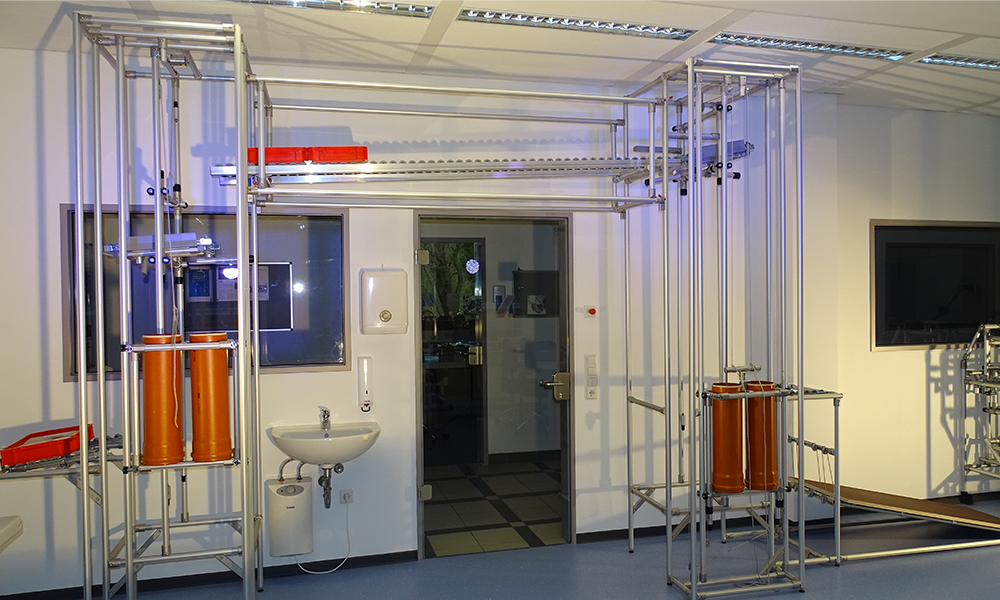
Achieving your aim faster with item components, engineering software and content
It’s also important that the Karakuri/LCA system can be dismantled with ease so that it can be showcased at trade fairs, too. Thanks to the straightforward fasteners of Profile Tube System D30, this is no problem at all. Comprising four sections in total, the system can be quickly dismantled and assembled by two people. Overall, the item components offered a key advantage: “Although we knew about Karakuri/LCA from a lecture, we’d never actually handled any components before starting on our practical project. The item components made the whole process intuitive and we were able to get building straight away, without any training,” says Hans Böhme, one of the students in the team. Another member of the project team, Malte Wörmer, highlights the positive learning experience: “It was very much learning by doing, which was a lot of fun”. The team used the item Engineeringtool to design large parts of the system, which made this stage of the work process much faster. Alongside the Comprehensive Catalogue of the Lean Production Building Kit System, videos on the item YouTube channel about both Karakuri/LCA and the item Engineeringtool also proved very helpful during the preparatory stage.
Karakuri/LCA is a frugal innovation – it sticks to the essentials and is also a durable, low-maintenance system that works perfectly.
Professor Ahrens’ description of lean production in general and Karakuri/LCA in particular as a “frugal innovation” is a telling one. “Frugal” means “simple” and “modest”, but can also mean “economical” and therefore by extension “serviceable”. A frugal innovation is one that sticks to the essentials and is also a durable, low-maintenance system that works perfectly. However, Karakuri/LCA and lean production are not synonymous – Karakuri/LCA is the most ambitious form of lean production. When you’re first rolling out lean production, other solutions such as lean factory equipment are great. However, compared to a conventional automation solution, Karakuri/LCA is often easier to implement and more cost-effective, too. Combining both forms of automation in a hybrid Karakuri/LCA system also offers a lot of potential: “You don’t necessarily need to choose between one or the other. You can also automate one part conventionally and another part mechanically. You can cut costs by doing that, too,” emphasises Professor Ahrens.
Are you interested in fascinating reports and innovations from the world of lean production? Then we have just what you’re looking for! Simply subscribe to the item blog by completing the box at the top right.

